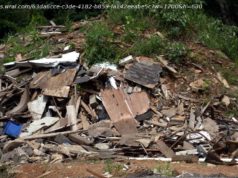Nearly a hundred people have been evacuated from their homes in Lynchburg, Va., after an intense storm amid concerns that an aging dam might fail and
Nearly a hundred people have been evacuated from their homes in Lynchburg, Va., after an intense storm amid concerns that an aging dam might fail and unleash dangerous floodwaters.
Video posted by the city overnight showed water flowing over the dam and into Blackwater Creek.
LuAnn Hunt, a city spokeswoman, tells NPR that 94 people took shelter at a local high school that’s serving as an evacuation center. They will remain there „until our weather event has passed and our dam is stabilized,“ she says.
Engineers have been assessing the situation at College Lake Dam.
„Currently, they have found no seepage at the dam so it is considered stable,“ Jes Gearing, public information officer for Lynchburg Water Resources, said in a statement emailed to NPR. „We are developing a plan to stabilize the dam which may include opening the sluice gate at the dam to reduce the water levels.“
Last night, the National Weather Service warned that the worst-case scenario — a complete dam collapse — could send 17 feet of water into the central Virginia city in just seven minutes.
By Friday, the threat was less severe, NWS forecaster Nick Fillo tells NPR. „The conditions have improved,“ he says. „After the heavy rain that fell yesterday evening, we just had some light to moderate rain, which hasn’t really added to the problem.“
Authorities were still being cautious. On Friday, the National Weather Service told residents that „the threat for dam failure continues“ and the flash flood warning remains in effect.
Lynchburg, with a population of around 80,000, is home to a number of colleges and universities, including the University of Lynchburg ( previously Lynchburg College), which owns the lake the dam is located on. Liberty University, the Christian university founded by Jerry Falwell, is also located in Lynchburg.
The dam was built in the early ’30s and, like many dams in the U. S., doesn’t meet current safety standards.
In 2011, Virginia’s Department of Conservation and Recreation identified the College Lake Dam as one of the state’s „high-hazard“ dams.
Since 2014, the City Council has been considering options for repairing or replacing the dam.
Turner Perrow, a member of the Lynchburg City Council who is also a civil engineer, tells NPR that the dam presents „a complicated problem.“ A major road for the city crosses over top of the dam, which is located right next to the University of Lynchburg. The lake behind it is filled with silt, which complicates potential solutions — if they removed the dam, for instance, they would need to ensure that the silt didn’t cause other problems downstream.
And every proposed fix would cost millions of dollars.
It’s a problem with fresh urgency. The city knew the dam couldn’t handle 2 feet of rain, the maximum it was supposed to be able to cope with, Perrow says. But the crew monitoring the dam last night raised concerns about structural integrity after just about six inches of rain.
„This dam is in worse shape than we thought it was,“ Perrow says. At the same time, he notes that „one of the opportunities coming out of this averted disaster is we may be able to tap federal funds for emergency preparedness to really fix the dam once and for all.“
Given the condition of the dam and the state of the lake, Perrow says, the most likely „fix“ isn’t actually a repair — he says the city is likely to tear the dam down completely and replace it with a bridge.






